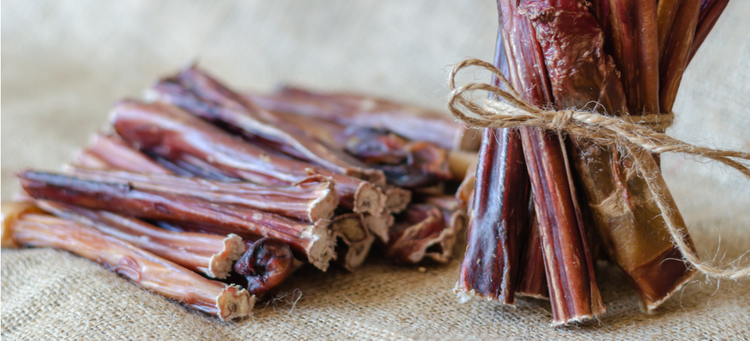
What Are Bully Sticks?
All-natural, single-ingredient bully sticks are a popular choice for satisfying your dog’s natural chewing instincts from their teething days to adulthood. In addition to redirecting destructive behavior, these snacks have the added benefit of preventing tartar buildup without exposing dogs to any potentially harmful additives. Bully sticks can raise eyebrows, however, because of that lone ingredient. These durable, chewable, increasingly-popular treats are made from dried bull penises.
What Are Bully Sticks Made From?
You read that right, bully sticks are made from bull or steer penises. Because the euphemism “bull muscle” is commonly used on packages and online, many pet owners are unaware of the origin of these treats.
Preparation methods will vary from brand to brand. Bully sticks (also known as pizzle sticks, steer sticks, or simply pizzles) are available raw, dried, or cooked and come in a range of shapes, including rings and braided sticks. They also come in several sizes to suit all types of chewers. Typically, the preparation process involves removing excess fat and thoroughly cleaning the raw product before drying, cooking, or otherwise preparing it for canine consumption.
Benefits of Bully Sticks
Just about anyone who’s ever owned a puppy can attest to the insatiable chewing that tends to coincide with their teething process. Dogs of every age enjoy chomping and gnawing, and durable treats like bully sticks provide an ideal distraction from inappropriate targets like furniture and clothing.
All that chewing helps your dog satisfy their cravings while discouraging the accumulation of plaque and promoting overall oral health. Chew treats aren’t a substitute for brushing, but they’re a great way to keep your pet’s breath fresh between visits to the veterinary dentist. Bully sticks generally last longer than other less durable chews. That means pets can chomp to their heart’s content without forcing pet parents to make countless trips to the pet store.
Drawbacks of Bully Sticks
Despite their various selling points, bully sticks are far from perfect and vets generally do not offer an unqualified recommendation. A Tufts University study from 2018 not only found that nearly 50% of owners had no idea what these treats were made from, but also discovered bacteria in around a third of samples. What’s more, they pack far more calories than many pet parents bargain for, around 88 in just one six-inch stick. That could make a pizzle stick a diet-busting treat for small and low-activity dogs in particular.
Another drawback that some pet owners can’t stomach is the unpleasant odor that emanates from certain brands of bully stick. Raw sticks, in particular, can tend to stink, releasing a scent that many pet owners say will outlast even intense cleaning. In response to this recurring issue, many manufacturers have adapted their preparation processes and now advertise their products as odor-free. Some of these manufacturers, including Red Barn and Best Bully Sticks, acknowledge that their products are not entirely odorless. In fact, the latter brand notes, chewing may actually introduce new odors to the product.
Like most chewable treats, bully sticks present a potential choking and obstruction risk. Closely observing dogs after introducing them to new treats can help ensure that both the size and texture is appropriate and that pets aren’t chewing overzealously. Once any bully stick is small enough to be swallowed whole, pet parents should discard them to reduce the risks of choking and esophageal or intestinal blockages.